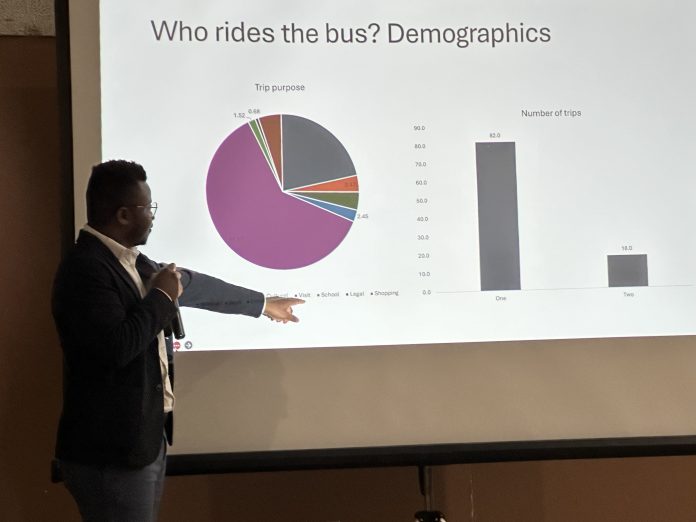
A team of researchers from the University of Saskatchewan were at the Kikinahk Friendship Centre in La Ronge to share their study on the free bussing provided by the Centre on Thursday, March 7.
The team included Dr. Jacob Alhassan and Dr. Cari McIlduff, of the University of Saskatchewan’s Department of Health and Epidemiology in Saskatoon.
Cari McIlduff, acted as MC, for the event, while Alhassan, comes with years of interest in the various aspects of transportation.
Alhassan completed his PhD thesis on the closure of the Saskatchewan Transportation Company and its impacts on Saskatchewan residents.
After hearing of the free bus service provided by the Kikinahk Friendship Centre, he approached Kikinahk to begin a study of the service, which could be used by Kikinahk as they search for funding to keep the five-day-a-week service after the end of March and possibly reduced service between then and the end of June.
In the initial results of the study, Alhassan reported on Impacts of the La Ronge Free Bus.
The focus of the report followed four components: Transportation as a social determinant of health; transportation and health equity in Saskatchewan; the La Ronge data; and the way forward.
“Globally, 1.5 million deaths and close to 80 million years of healthy life are lost through motorized road transportation. In many places there are rural-urban difference in accident mortality with more accidents occurring in the rural areas. Buses are one of the safest modes of travel,” reads the research.
According to his data, Alhassan determined Saskatchewan has the second highest rate of accidents, with only the Yukon Territory having more, which compares to provinces with smaller populations, such as Quebec and British Columbia, for example.
Modes of transportation have an impact “can determine physical activity levels.” For example, walking to and from home to access public transportation “improves mental health.”
Healthcare can be impacted by vehicle access, rural or urban geography and travel can be burdened by time and distance.
Other areas impacted by transportation include access to jobs, levels of poverty and can impact the health through environmental impacts and air pollution.
A wide area of health issues are related to transportation, such as wasted time, access to healthcare, physical activity, and air pollution.
In a community where people are often sent south for healthcare, transportation is a major issue.
Physical activity can be affected by cardiovascular disease, cancer, obesity. People’s mental health can be affected by noise, and carbon emissions impact global environmental and human health, to name a few possibilities in terms of transportation.
The Case of STC, the Saskatchewan Crown corporation, had been in existance since 1946, served 253 communities and ran 2..8 million miles carrying medical equipment and parcels; it was closed May 2017, according to the report.
Some of the impacts for Saskatchewan people included: missed appointments and health system impacts, Alhassan quoted his data gathered in 2021.
For some it resulted in psychosocial health impacts such as loneliness, stress, disconnection and loss of independence.
Talking about the environmental impacts, a 21-year-old male from Prince Albert, is quoted as saying, “I have to live this way. [Being forced to buy a car.] It’s like a if a vegetarian was forced to eat meat.”
To break down the demographics of the free bus service, Alhassan used gender and age.
In 1,185 trips, 71 adults took the bus, seven children, 22 elders, and there were 53 females and 47 males.
The pickup points, of Kikinahk, Air Ronge and Prince albert were: 41 Prince Albert, 30 Kikinahk and 29 Air Ronge.
The reasons for using the service include, medical, work, errands, cultural, visiting, school, legal and shopping.
The second part of the event, gathering information and ideas for the way forward.
Participants met in small groups to discuss the impacts the bus has had and why it’s needed.
They discussed, in small groups, such questions as: how to improve transportation access for vulnerable people, the major strength of the bus service, and collaborative opportunities that in the community and beyond to sustain and expand the current service.
Some of the benefits: access to health care, that doesn’t involve having to search for a ride every time it’s needed; a service where everyone is welcome to use; safety, for people, particularly women, who have been forced into hitchhiking with the closure of STC; people know the schedule and how to register for the bus, and where to get the bus.
And the real hope – to offer a bus service, twice daily to Prince Albert and Saskatoon, seven days a week.

